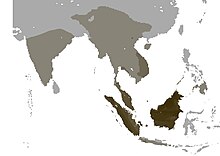| Treeshrews[1] Temporal range: Middle Eocene – Recent
| |
|---|---|

| |
| Tupaia sp. | |
| Scientific classification | |
| Domain: | Eukaryota |
| Kingdom: | Animalia |
| Phylum: | Chordata |
| Class: | Mammalia |
| Grandorder: | Euarchonta |
| Order: | Scandentia Wagner, 1855 |
| Families | |

| |
| Red: Tupaiidae, Blue: Ptilocercidae , Purple: both Tupaiidae and Ptilocercidae | |

| |
| The distribution and density of treeshrew species. | |
The treeshrews (also called tree shrews or banxrings[3]) are small mammals native to the tropical forests of South and Southeast Asia. They make up the entire order Scandentia, which split into two families: the Tupaiidae (19 species, "ordinary" treeshrews), and the Ptilocercidae (one species, the pen-tailed treeshrew).
Though called 'treeshrews', and despite having previously been classified in Insectivora, they are not true shrews, and not all species live in trees. They are omnivores; among other things, treeshrews eat fruit.
Treeshrews have a higher brain to body mass ratio than any other mammal, including humans,[4] but high ratios are not uncommon for animals weighing less than 1 kg (2 lb).
Among orders of mammals, treeshrews are closely related to primates, and have been used as an alternative to primates in experimental studies of myopia, psychosocial stress, and hepatitis.[5]
- ^ Helgen, K.M. (2005). "Order Scandentia". In Wilson, D.E.; Reeder, D.M (eds.). Mammal Species of the World: A Taxonomic and Geographic Reference (3rd ed.). Johns Hopkins University Press. pp. 104–109. ISBN 978-0-8018-8221-0. OCLC 62265494.
- ^ "Appendices | CITES". cites.org. Retrieved 2022-01-14.
- ^ Rines, George Edwin, ed. (1920). . Encyclopedia Americana.
- ^ "an article on Tupaia belangeri". The Genome Institute. Washington University. Archived from the original on 1 June 2010.
- ^ Cao, J.; Yang, E.B.; Su, J.-J.; Li, Y.; Chow, P. (2003). "The tree shrews: Adjuncts and alternatives to primates as models for biomedical research" (PDF). Journal of Medical Primatology. 32 (3): 123–130. doi:10.1034/j.1600-0684.2003.00022.x. PMID 12823622. S2CID 16910445. Retrieved 1 January 2012.